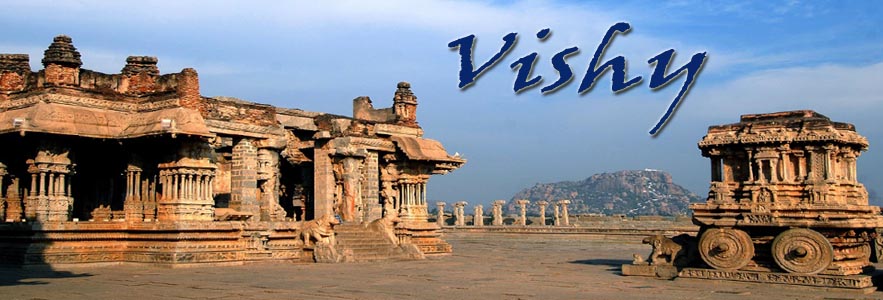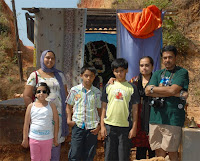PHOTOGRAPHY WILDLIFE OUTING TO RANTHAMBORE NATIONAL PARK -
FROM 15TH JAN 2010 TO 18TH JAN 2010
THE TEAM
SATISH H
VISHWANATH.S
SATEESH.N
ARJUN HAARITH
We left Jaipur on 15th Jan 2010 by MaruSagar Expresee by 10.20 am and reached Sawai Madhopur by 12-45 afternoon. We had booked the Safari trips through online by http://www.rajasthanwildlife.in/ (for further enquiries clarifications anyone can connect to the website or email to ranthambore@rajasthanwildlife.in.)
First trip in the Afternoon of 15th Jan 2010, We had Alloted Route No. 4 :
This route has beautiful lakes of Ranthambore.
The three big lakes - Padam Talab (meaning Lake), Malik Talab and Raj Bagh are the water bodies providing life to the fauna of the park and to the aquatic vegetation like lotus, lilies and duckweeds. Chambal River in the north, Banas River in the south and around six artificial lakes are some of the other water bodies in the Ranthambore. The national park remains open for tourists, between the months of October and June. Apart from the Royal Bengal Tiger, the park is a haven for large number of other animals and birds, which also fall a prey to Tiger.
They are : Rajbagh Lake.,
Rajbagh is the second largest lake among the three lakes in Ranthambore. Rajbagh Talao has whippings that protract to the bulge of the lake. The water plants in the lake offer the mud deer with indolence to tickle on. Tigers can rarely be seen near Rajbagh Talao.
Padam Talao :is is the largest of the lakes present in the park. The famous and beautiful Jogi Mahal is located at the very edge of this lake. When in season, the water lilies that give the lake it's name, can be seen in plenty. In the early hours of the morning and just before sunset, animals can be seen in large numbers on the lake side. It is in the shallow waters of this lake that the famous "lake hunters" of Ranthambore operate, the most legendary of which was the tiger, Genghis. It is also along this lake's edges that the rare sighting of the chinkara is most probable
Mallik Talao
The Safari on Route no.3 was worth that day, as we took pictures of Sambhars , treepies , Bar headed geese etc., with some landscapes too. According to me route 3 is one of the best routes in the park.
In the Rajbagh Lake we shot some pics of Sambar and some species of Birds and then moved towards Mallik Talau here we captured Bar Headed Goose and Brahmini Ducks, Hoopoe,and friendly bird like Treepie's
16th Jan 2010- Day 2 (Morning Trip No-2) : Alloted Route no 4 Guide:
We found Chitals & Sambars. After shooting pictures of the sighted some species of birds, we had to returned back empty handed (I mean not much of shooting the pics)
Day 2 (Evening Trip No-3) : Alloted Route No 4: Guide:
In the afternoon, it was lucky. we were shooting some birds like brahmni ducks, cormonant, and Sambars near Mallik talao in route 4, suddenly a gypsy,far away place gave us a signal, our gypsy driver went there in a moment. And we were amazed to witness a royal tigress sitting in a bush. It was T-17. After 30 mins, it came out of the bush and followed the path along with the gypsies.
After a while the tigress waited patiently to hunt a sambar,nearly for 15-20 mts, but at certain point of time an alarm call was heard and sambars took to their heels. After the majesticanimal's sighting we returned back.
Day 3 (Morning Trip No.4) Alloted Route No. 2: Guide :Mr. Salim Ali.: As soon as we entered the Entry Gate, a gigantic Nilgai was in the road, we had to remove the camera, till then it was on the road, we shoot some pics of nilgai and moved forward in search of sigthing, after a while, suddenly a male tiger came out of the bush. It was T-23 male.
Day 3 (Evening Trip No. 5) Alloted Route No. 1
The Route was backside of the Fort Area, where we found nothing but Wild Boars and Languors
Day 4 (Morning Trip No. 6) Alloted Route No. 5
This was the second last safari of our trip. It was very cold in the morning. It was a fog hit day. We got up the gypsy and went inside the forest, we heard alarm calls given by Chitals and Langurs, suddenly the beautiful queen T-17 appeared on the road. We went through the mist under a very less viewing distance due to the mist. The entire forest area was covered under the clouds when we went up hill atop. After a Break near Forest Guards Room and continued the safari... After that we drove further, went up the hill and our gypsy got struck on hill for few minutes, later our Driver Bhaiyya managed and we came back we had a nice safari and took few landscape pictures including the Human Friendly TREEPIE Bird. after lunch in our hotel we had a nice sightings of birds including Kingfisher, Hoopoe,Red Vented Bulbul, Spotted Owlet etc we had a nice afternoon after lunch
Day 4 ( Evening Trip No. 7) Alloted Route No 4 :
It is a highlight to see the Tigers in their natural habitat and multiple safari's might be necessary.
Ranthambore National Park is one of the top places to see a tiger in its natural environment in India. The usual way of spotting a tiger is to take a jeep safari though the park. However, lately visitors haven't had to go looking for tigers in Ranthambore. They've been venturing so close to the edge of the park that guests have been able to see them from their hotels.
This is taken to be a good sign in terms of the tiger population at the park as tigers are territorial, and apparently venture out of the core area in search of space and prey.
As a Gist of our Tour We had sighted following gigantic animal of Ranthombore and Various Species of Birds
15.01.10 – Route # 3
16.01.10 – Route # 4 (sighted T17 & T 28)
17.01.10 – Route # 2 (Sighter T23 & T13)
17.01.10 – Route # 1 (did not sight Tigers)
18.01.10 – Route # 5 (sighted T17 again)
18.01.10 – Route # 4 (sighted again T17)
In route # 3, you see Padam Lake, Rajbagh & Malik Lake
BIRDS SIGHTED IN RATHAMBORE
BAR HEADED GHEESE, TREEPIE, PEACOCK, BABLERS, BRAHMINY DUCKS,. PIN TAILED DUCK, FLY CATCHER, DARTER, RED WATTLED LAPWING, BLACK WINGED STILT, GOLDEN BACKED WOODPECKER, PIED KINGFISHER, WHITE BREASTED KINGFISHER, BAY BACKED SHRIKE, SOUTHERN GREY SHRIKE, BLACK SHOULDERED KITE, PATRIDGE, RED WENTED BUL BUL, KING VULTURE, HOOPOE, PURPLE SUNBIRD, SPOTTED OWLET, SPOTTED DOVE, JUNGLE WARBLER, ASHY PRENIA, PLUM HEADED PARAKEET, ROSE RINGED PARAKEET, ALEXANDRINE PARAKEET, CREASTED SERPENT EAGLE, BLUE ROCK PIGEON, GREEN BEA EATER, BRAHMINY MYNA, BANK MYNA, MAGPIE ROBIN, COMMON MYNA, COUCAL, DRANGO, BUSHCHAT, COCKOO, WHITE IBIS, PAINTED SPURFOWL,SPOTTED DOVE, EURASIAN COLLARED DOVE, SANDPIPERS, REDSHANK, GREEN SHANK, BLACK WINGED KITE, SHIKRA, CORMORANT, GREY HERON, POND HERON, GREY WAGTAIL & BARN SWALLOW.
We stayed at “ TIGER LODGE AND RESTAURANT “
owner by Mr. Sushil Singh Chauhan (Bhaiya) .
His contacts are : 00917462-222212 / 09414307921
E-Mail id:sushilswm@yahoo.co.in
Full Information about Ranthtamobe National Park (RNP)
Location: East Rajasthan, 11km away from Sawai MadhopurClothing : Summer : light tropical :Location: East Rajasthan, 11km away from Sawai MadhopurClothing : Summer : light tropical :
Climate: Summer : (42oc max and 22oc min),
Winter: (20oc max and 11oc min)
Rainfall : 68 cms
Winter : Light wollen
Ranthambore National Park (STD Code 07462)1955 as a sanctuary, 1973 as a tiger reserve, Area : 400 sq km approx./ 39,200 hectares.
Established :
1981 as a national park.Park Safari Timings in Ranthambhore
National Park:Months Morning Afternoon
October-March 0600-0900 21500-1800hrs
April-June 0630-0930 1530-1800 hrs
Access : Fly toJaipur (the closest airport) and drive to Ranthambore (165 kms) By train :
Ranthambore National Park is approx. 12 km from the Sawaimadhopur Railway station, that lies on the Delhi to Mumbai trunk route.
Languages: Hindi, Rajasthani and English
Best Time to visit: October to March
Major Attractions: Ranthambhore National Park, Ranthambhore Fort, Raj
Bagh Talab, Jogi Mahal, Padam Talab, Malik Talab, Jain Temples, etc
Description:
RANTHAMBORE NATIONAL PARK : is one of the prime examples of Project Tiger’s conservation efforts in Rajasthan. The forests around the Ranthambore Fort were once, the private hunting grounds of the Maharajas of Jaipur. The desire to preserve the game in these forests for sport, was responsible for their conservation, and subsequent rescue by Project Tiger.The Park sprawls over an estimated area of 400 sq kms. Steep crags embrace a network of lakes and rivers, and a top one of these hills, is the impressive Ranthambore Fort, built in the 10th century. The terrain fluctuates between impregnable forests and open bushland. The forest is the typically dry deciduous type, with dhok, being the most prominent tree. The entry point to the Park, goes straight to the foot of the fort and the forest rest house, Jogi Mahal. The latter boasts of the second-largest banyan tree in India. The Padam Talab, the Raj Bagh Talab and the Malik Talab are some of the lakes in the area, that attract the tiger population. They have been spotted at the edges of these lakes, and Jogi Mahal itself. Old crumbling walls, ruined pavilions, wells, and other ancient structures stand witness to the region's glorious past. The entire forest is peppered with the battlements and spillovers of the Ranthambore Fort - tigers are said to frequent these ruins, too. As a result of stringent efforts in conservation, tigers, the prime assets of the Park, have become more and more active during the day. More than in any other park or sanctuary in India, tigers are easily spotted here in daylight. They can be seen lolling around lazily in the sun, or feverishly hunting down Sambar around the lakes.
Mammals:
Hanuman Langur, Sloth Bear, Common Palm Civet,Ruddy Mongoose, Caracal, Fishing Cat,Wild Boar Nilgai Indian porcupine,Golden Jackal Ratel Small Indian Mongoose, Striped Hyena, Jungle Cat, Leopard,Chital, Indian Gazelle Indian Hare,Bengal Fox, Small Indian Civet ,Indian Grey Mongoose, Leopard Cat, Wild Cat, Tiger,Sambar, Northern Palm Squirrel
Tariff Per Seat in Indian Rupees.
Park Visit Charges For Canter (Diesel)
Indian - 334.00
Indian Student - 313.00
Non-Indian - 513.00
Park Visit Charges For Gypsy
Indian - 429.00
Indian Student - 408.00
Non-Indian - 608.00
Park Visit Charges For Canter (Petrol)
Indian - 364.00
Indian Student - 344.00
Non-Indian - 544.00
In the afternoon, This is also one of the most beautiful routes of Ranthambhore. Before the Forest Check Point enroute to safari, we found plumhead parakeets, While driving, the driver noticed few pug marks. We waited for a while and again T-17 appeared. On the D-Day of our Safari (I mean the last trip), it was T-17 gave darshan and walked besides our Gypsy and then took a turn and went towards other area not belonging to T-17. That was an amazing experience, The Sighting and Lighting for our Photographs was one of the best.









































